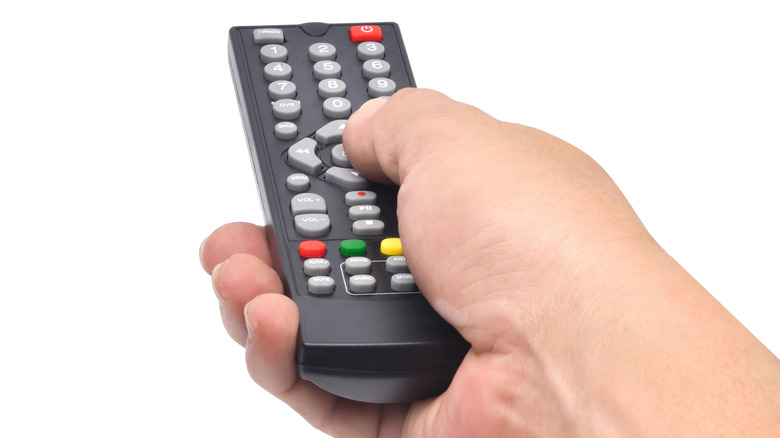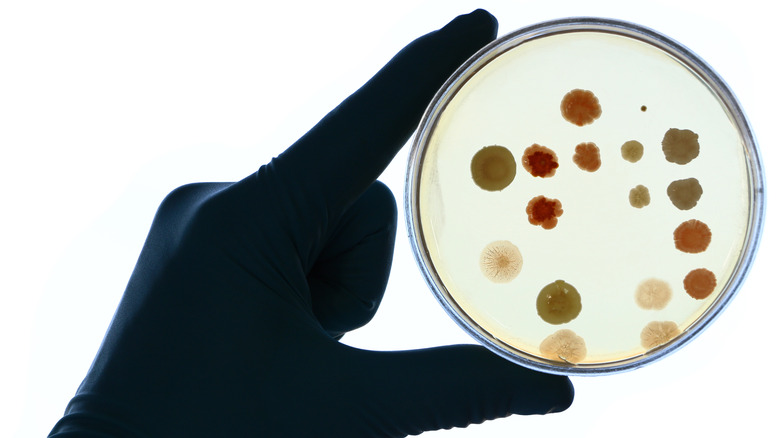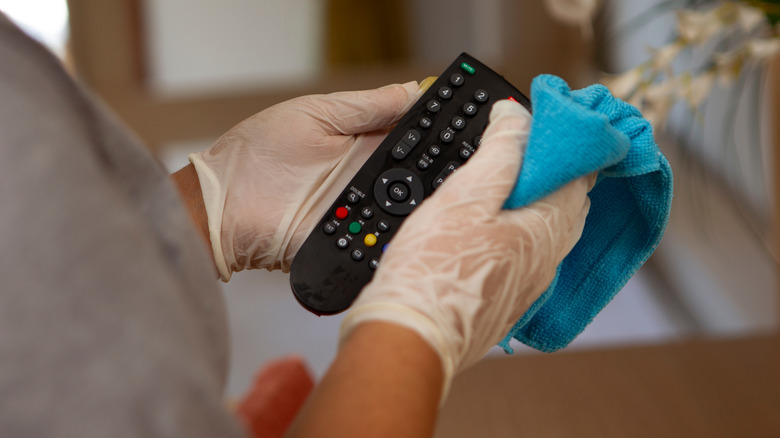Your TV Remote Has More Germs Than You Think
When deep cleaning your home, you're probably focusing on target areas such as the toilet, under the bed, or shower walls — and rightfully so. No doubt these areas can get visibly grimy from daily usage, but you may also be neglecting items in your home that aren't so germy to the eye.
Frequently touched items are among the dirtiest things around us. Think about our phone screens, soap dispensers, and grocery store shopping carts. An item that also falls into the frequently touched category is our television remote. If you don't believe us, consider how often people wash — or rather, don't wash — their hands throughout the day. According to a 2021 survey of 1,531 adults in the U.S., less than half stated that they "always" use soap while washing their hands, indicating that 51% of respondents don't always do so. Even worse, 32% of participants reported that they don't always wash their hands after going to the bathroom.
As a result, particles of fecal matter can easily make their way to our clicker, in addition to bacteria and viruses that can make us sick.
Just how dirty are TV remote controls?
According to the Times of India, research has revealed that our household channel-changers outrank the bathroom toilet seat when it comes to germ count. When assessing for the presence of yeast and bacteria, researchers found "290 colony-forming units per [2 centimeters]" on the remote control, as opposed to only "12.4 colony-forming units per [2 centimeters]" detected on the toilet seat. "The results of our research are shocking, with TV remotes, in particular, being shown to harbor extreme amounts of bacteria, yeast and mold," said Dale Gillespie, head of acquisition at ScS (per Times of India).
But the TV remote in your home likely isn't the only one you're using. A 2012 study conducted by the American Society for Microbiology determined television remotes to be among the dirtiest items found in hotel rooms. Reinforcing these findings, researchers at the University of Arizona have concluded that hotel room remote controls are contaminated with more bacteria than the room's bedspread, doorknobs, or toilet (via Clean Remote).
What kinds of germs live on remotes?
One reason why our TV remotes house so many germs is because more than one person touches them. Even if your family doesn't watch a lot of television, the remote still ends up being a collection of germs. You may be wondering why a lesser-used remote might still be germy, and the reason is that remotes are rarely cleaned, giving germs plenty of time to build up, per Insider.
With all this talk about germs, you might be wondering just what kinds of viruses make their way to your remote. "The Germ Files" author Jason Tetro cited a 2012 study conducted by the Journal of Infection Prevention that found staphylococcus aureus, a bacteria that can cause skin infections and pneumonia, on remotes. The study also discovered E. coli, klebsiella pneumoniae, and enterococcus faecalis, all bacteria found in stools that can cause a host of conditions including diarrhea, pneumonia, and urinary tract infections. In addition, they found pseudomonas aeruginosa, which generally isn't harmful unless it makes its way into an open wound (via MEL).
Viruses can linger on remotes
If someone in our home is sick, that just increases the amount of bacteria on the remote. SFGate reports that cold germs like to hang out on remotes as much as they do anything else, and they can survive on them for two days or longer.
To discover just how many viruses like to linger on objects, researchers from the University of Virginia tested 30 people with cold symptoms. They asked the participants to name the places in their homes that they touched in the previous 18 hours. The objects they listed included remotes, doorknobs, refrigerator handles, and bathroom faucets. Researchers then tested the objects and found that they tested positive for cold germs about 40% of the time. When it came to remotes, six out of ten were contaminated. While the presence of germs does not guarantee that a person who touches a remote will get sick, it does suggest a risk, per SFGate.
This is how often you should clean your TV remote
When examining the viral contamination of remote controls, researchers at the University of Virginia detected the presence of cold viruses on half of the controllers they tested (via MedicalNewsToday). Considering that research has shown that individuals can touch their face as many as 23 times an hour, regularly touching an unclean TV remote increases the chances of transmission of these viral particles.
Meaghan Murphy, editor of Good Housekeeping, explains that television remote controls should be cleaned and sanitized once a month (via TODAY). Additional cleanings are advised if a family member has recently been ill. To do so, use a cloth to give the remote a thorough wipe-down with rubbing alcohol. To get to those nooks and crannies, apply rubbing alcohol on a cotton swab and maneuver it between the buttons. If there's buildup underneath the buttons themselves, a toothpick can be helpful in reaching it. Dry the TV remote upon completion, and remember to always remove the batteries prior to cleaning.





